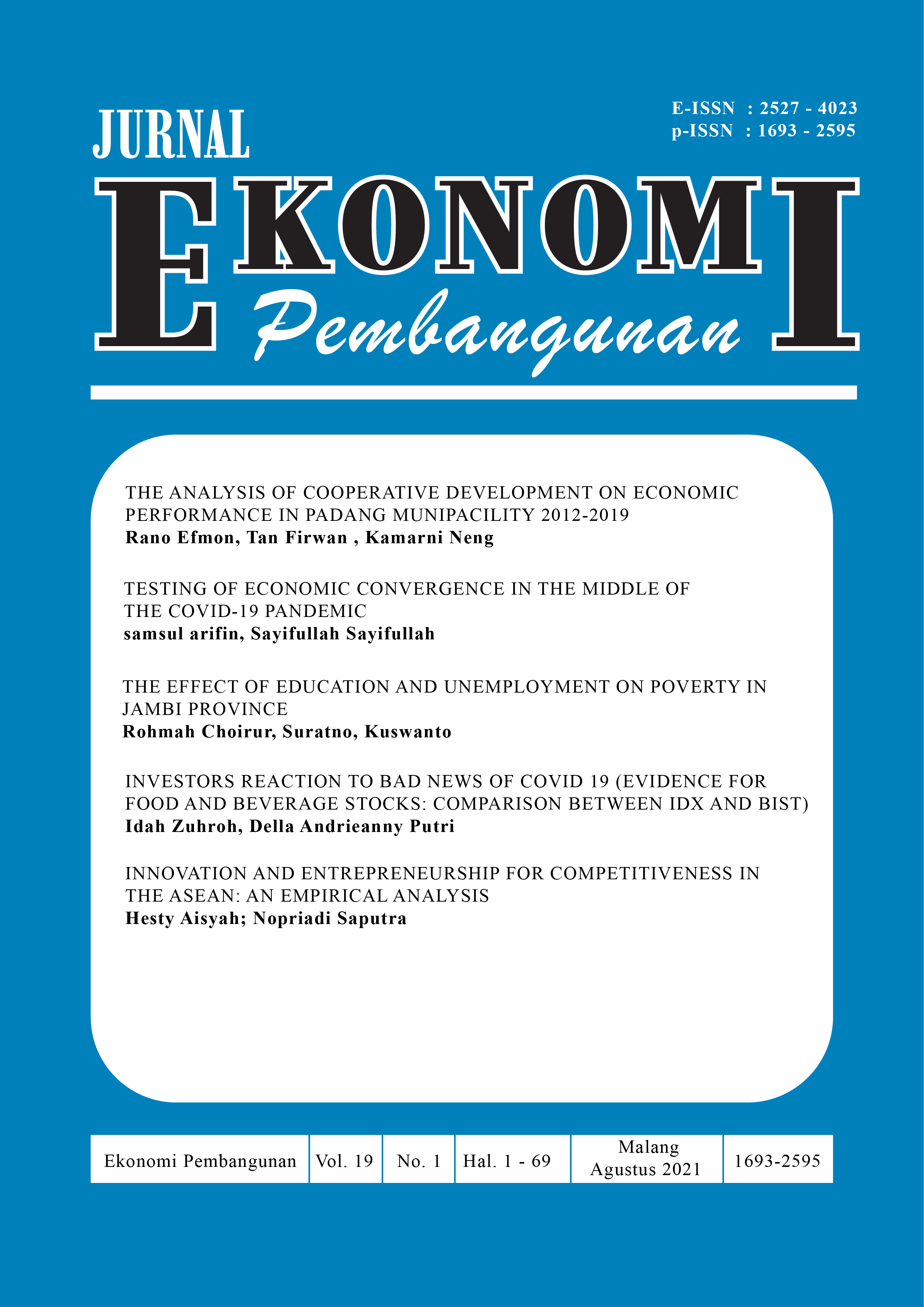The Effect of Education and Unemployment on Poverty in Jambi Province
DOI:
https://doi.org/10.22219/jep.v19i01.16817Keywords:
Education, Unemployment, PovertyAbstract
This study aimed to determine the effect of education and unemployment on poverty in Jambi Province. This study uses quantitative methods to analyze the impact of the average length of schooling, expected years of schooling, and the open unemployment rate on poverty in Jambi Province for the 2017-2019 period. The subjects of this study were residents of every district and city in Jambi Province. The type of data in this study is secondary data obtained and collected indirectly from the object under investigation. The things of this research are nine districts and two cities in Jambi province for the period 2017-2019 from the official portal of the Central Statistics Agency (BPS) Jambi Province. The data used are the average length of schooling (RLS), expected years of education (HLS), and the open unemployment rate (TPT), and the number of poor people in Jambi Province in the 2017-2019 period. The results of the study show that education and unemployment simultaneously affect poverty in Jambi Province
Downloads
References
Amins, D. B. (2017). Pengaruh Tingkat Pengangguran Terhadap Tingkat Kemiskinan Di Kabupaten Berau. Economy Bring Ultimate Information All About Development Journal, 1(2), 112–124.
Annur, R. A. (2013). Faktor-Faktor Yang Mempengaruhi Kemiskinan Di Kecamatan Jekulo Dan Mejobo Kabupaten Kudus Tahun 2013. Economics Development Analysis Journal, 2(4), 409–426. https://doi.org/10.15294/edaj.v2i4.3209
Aziz, G. A., Rochaida, E., & Warsilan. (2016). Faktor Faktor yang Mempengaruhi Kemiskinan di Kabupaten Kutai Kartanegara. Jurnal Ekonomi Keuangan Dan Manajemen, 12(1), 29–48.
Bappenas. (2015). Analisis Provinsi Jambi 2015. In Seri Analisis Pembangunan Wilayah Provinsi Jambi. Jambi. Retrieved from https://simreg.bappenas.go.id/assets/temaalus/document/Publikasi/DokPub/Analisis Provinsi Jambi 2015_ok.pdf
Barro, R. J. (2007). Economic growth in a cross section of countries. Quarterly Journal of Economics, 106(2), 407–443. https://doi.org/10.2307/2937943
BPS. (2021). Konsep/Penjelasan Teknis Tenaga Kerja. Retrieved from BPS - Statistics Indonesia website: https://www.bps.go.id/subject/6/tenaga-kerja.html
BPS Provinsi Jambi. (2019). Indeks pembangunan manusia provinsi Jambi 2019. Jambi: Badan Pusat Statistik Provinsi Jambi.
Djatmiko, G. (2019). Angka Putus Sekolah Masih Tinggi (Pernikahan Dini Jadi Penyebab). Retrieved May 5, 2021, from Jambi Independent website: https://www.jambi-independent.co.id/read/2019/02/21/36009/angka-putus-sekolah-masih-tinggi
Firdaus, M., & Irawan, T. (2009). Modul I Ekonometrika Untuk Data Panel (Aplikasi Eviews Dan Stata). Malang: Universitas Brawijaya.
Greene, W. H. (2003). Econometric Analysis 4th Ed. New Jersey: Pearson Education Inc.
Gujarati, D. N. (2006). Dasar-Dasar Ekonometrika Jilid 1 (3rd ed). Jakarta: Erlangga.
Huebener, M., & Marcus, J. (2017). Compressing Instruction Time Into Fewer Years of Schooling And The Impact on student Performance. Economics of Education Review, 58, 1–14. https://doi.org/10.1016/j.econedurev.2017.03.003
Iqbal, M., Junaidi, & Hardiani. (2018). Analisis pengaruh tingkat pengangguran , pertumbuhan penduduk , tingkat kemiskinan dan indeks pembangunan manusia terhadap pertumbuhan ekonomi di Kabupaten Tanjung Jabung Barat. Ekonomi Sumber Daya Dan Liingkungan, 7(3), 144–157.
Karisma, A., & Soejoto, A. (2013). Pertumbuhan Ekonomi dan Pengangguran Terhadap Kemiskinan di Jawa Timur. Jurnal Pendidikan Ekonomi (JUPE), 1(3), 1–15. https://doi.org/https://doi.org/10.26740/jupe.v1n3.p%25p
Koestoer, R. H., Hasibuan, H. S., Cessna, A. F., Amadira, G., Safrizal, A., & Supriyanto, E. (2016). Telaah Hubungan Ekonomi dan Pembangunan Manusia dan Kebudayaan (Kumpulan Telaah Aspek Pembangunan Ekonoi, Manusia dan Kebudayaan. Jakarta: Program Studi Ilmu Lingkungan Sekolah Ilmu Lingkungan Universitas Indonesia Jakarta.
Mahroji, D., & Nurkhasanah, I. (2019). Pengaruh Indeks Pembangunan Manusia Terhadap Tingkat Pengangguran di Provinsi Banten. Jurnal Ilmu Ekonomi, 9(1), 51–72. https://doi.org/10.35448/jequ.v9i1.5436
Mankiw, G. N. (2012). Pengantar Ekonomi Makro. Jakarta: Erlangga.
Niswati, K. (2014). Faktor-faktor yang Mempengaruhi Kemiskinan di Daerah Istimewa Yogyakarta Tahun 2003-2011. Pembangunan Ekonomi Wilayah, 9(2), 82–89.
Pradipta, S. A., & Dewi, R. M. (2020). Pengaruh Rata-Rata Lama Sekolah dan Pengangguran Terbuka Terhadap Kemiskinan. Jurnal Pendidikan Ekonomi (JUPE), 8(3), 109–115. https://doi.org/10.26740/jupe.v8n3.p109-115
Pratowo, N. I. (2011). Analisis Faktor-Faktor Yang Berpengaruh Terhadap Indeks Pembangunan Manusia. Jurnal Studi Ekonomi Indonesia, 1(1), 15–31.
Safuridar, & Putri, N. I. (2019). Pengaruh Indeks Pembangunan Manusia , Pengangguran Dan Jumlah Penduduk Terhadap Tingkat Kemiskinan Di Aceh Bagian Timur. Jurnal Samudra Ekonomika, 3(1), 34–46. Retrieved from https://www.ejurnalunsam.id/index.php/jse/article/view/1295
Seran, S. (2017). Hubungan antara Pendidikan, Pengangguran, dan Pertumbuhan Ekonomi dengan Kemiskinan. Jurnal Ekonomi Kuantitatif Terapan, 10(2), 59–71. https://doi.org/10.24843/jekt.2017.v10.i01.p07
Sugiyono. (2013). Metode Penelitian Kuantitatif, Kualitatif, dan R & D. Bandung: Alfabeta.
Widarjono, A. (2017). EKONOMETKIKA : Teori dan Aplikasi Untuk Ekonomi dan Bisnis. Yogyakarta: Ekonisia Fakultas Ekonomi UII.
Yakunina, R. P., & Bychkov, G. A. (2015). Correlation Analysis of the Components of the Human Development Index Across Countries. Procedia Economics and Finance, 24(July), 766–771. Elsevier B.V. https://doi.org/10.1016/s2212-5671(15)00692-9
Downloads
Published
Issue
Section
License
Copyright (c) 2021 Jurnal Ekonomi Pembangunan

This work is licensed under a Creative Commons Attribution-ShareAlike 4.0 International License.
Authors who publish with Jurnal Ekonomi Pembangunan (JEP) agree to the following terms:
- For all articles published in Jurnal Ekonomi Pembangunan (JEP), copyright is retained by the authors. Authors permit the publisher to announce the work with conditions. When the manuscript is accepted for publication, the authors agree to the publishing right's automatic transfer to the publisher.
- Authors retain copyright and grant the journal right of first publication with the work simultaneously licensed under a Creative Commons Attribution-NonCommercial-ShareAlike 4.0 International License that allows others to share the work with an acknowledgment of the work's authorship and initial publication in this journal.
- Authors can enter into separate, additional contractual arrangements for the non-exclusive distribution of the journal's published version of the work (e.g., post it to an institutional repository or publish it in a book), with an acknowledgment of its initial publication in this journal.
- Authors are permitted and encouraged to post their work online (e.g., in institutional repositories or on their website) before and during the submission process, as it can lead to productive exchanges and earlier and greater citation of published work (See The Effect of Open Access).

This work is licensed under a Creative Commons Attribution-NonCommercial-ShareAlike 4.0 International License.






















